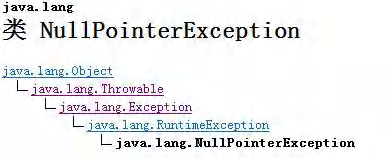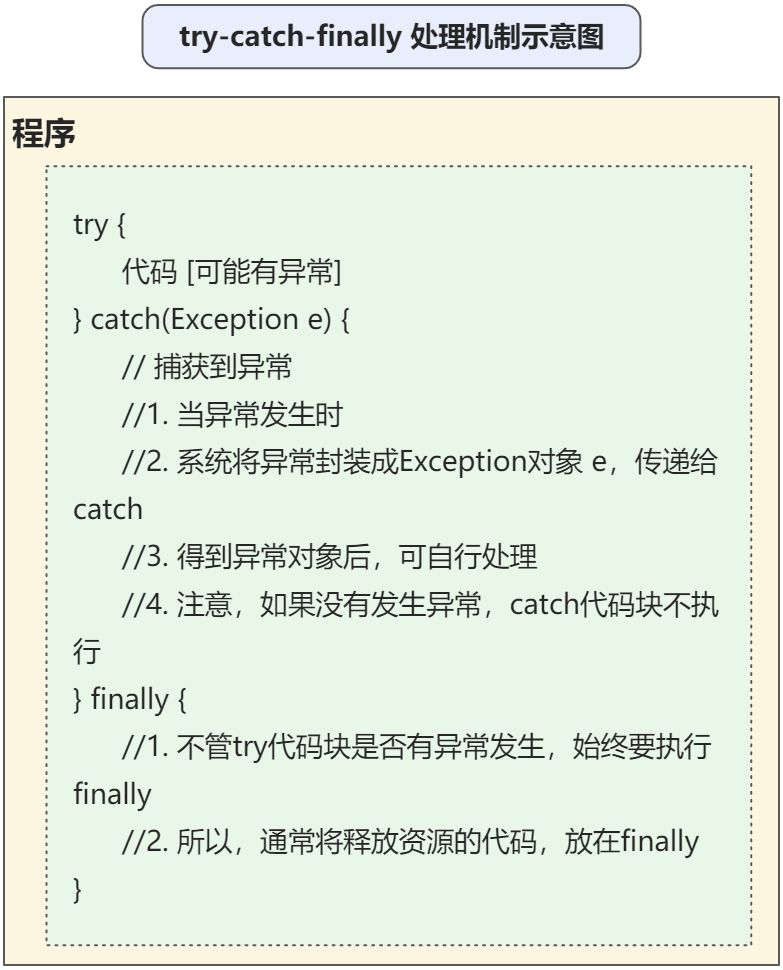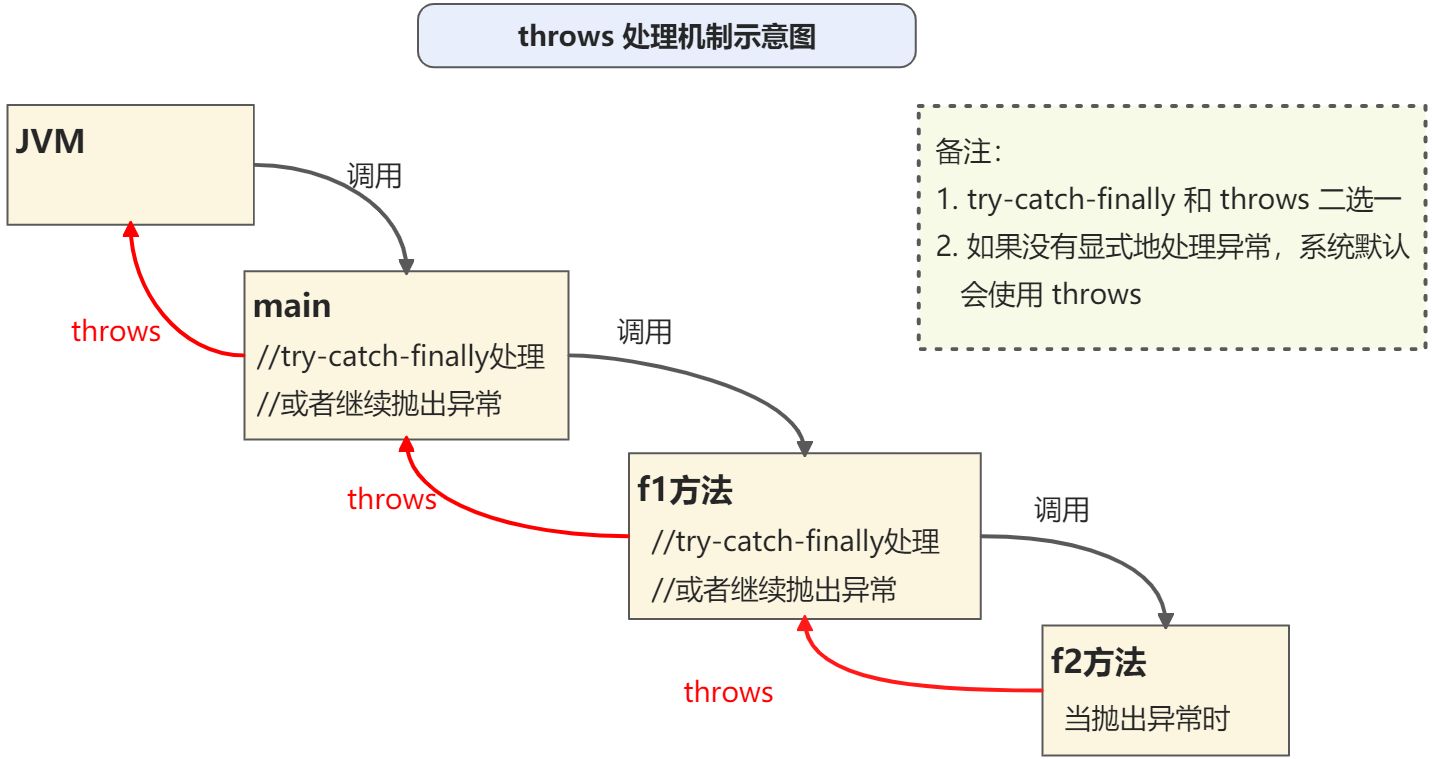一、异常的概念
1.1 问题引入
package com.hspedu.exception_;/*** @author HarborGao* @version 1.0*/public class Exception01 {public static void main(String[] args) {int num1 = 100;int num2 = 0;//解读://1. num1 / num2 => 10 / 0//2. 当执行到 num1 / num2 因为 num2 = 0 ,程序就会抛出异常 ArithmeticException//3. 当抛出异常后,程序就崩溃了,下面的代码就不再执行//4. 思考:这样的程序好吗?不好,不应该出现了一个不算致命的问题,就导致整个系统崩溃//5. Java设计者,提供了一个叫 异常处理机制来解决该问题int res = num1 / num2;System.out.println("程序继续运行...");}}
解决方案 - 异常捕获
如果程序员 认为一段代码可能会出现异常/问题,可以使用 try-catch异常处理机制来解决,从而保证程序的健壮性。如果进行了异常处理,即使程序出现了异常,也会继续执行。
将代码块选中 -> 快捷键 ctrl + alt + t -> 选中 try-catch
try {int res = num1 / num2;} catch (Exception e) {//e.printStackTrace();System.out.println(e.getMessage()); //输出异常信息}
1.2 基本概念
Java语言中,将程序执行中发生的不正常情况称为“异常”。(注意:开发过程中的语法错误和逻辑错误不是异常)
执行过程中所发生的异常事件可分为两类:
- Error(错误):Java虚拟机无法解决的严重问题。如:JVM系统内部错误、资源耗尽等严重情况。
比如:StackOverflowError【栈溢出】和OOM (out of memory),Error是严重错误,程序会崩溃。 - Exception:其他因编程错误或偶然的外在因素导致的一般性问题,可以使用针对性的代码进行处理。例如空指针访问,试图读取不存在的文件,网络连接中断等等,Exception分为两大类:运行时异常【程序运行时发生的异常】和编译时异常【编程时,编译器检查出的异常】
二、异常体系图
2.1 异常体系图小结
- 异常分为两大类,运行时异常和编译时异常。
- 运行时异常,编译器不要求强制处置的异常。一般是指编程时的逻辑错误,是程序员应该避免其出现的异常。java.lang.RuntimeException 类及它的子类都是运行时异常。
- 对于运行时异常,可以不作处理,因为这类异常很普遍,若全处理可能会对程序的可读性和运行效率产生影响。
- 编译时异常,是编译器要求必须处置的异常。
三、常见的异常
3.1 NullPointException 空指针异常
当应用程序试图在需要对象的时候使用 null 时,抛出该异常

public class NullPointException_ {public static void main(String[] args) {String name = null;System.out.println(name.length());}}

3.2 ArithmeticException 数学运算异常
当出现异常的运算条件时,抛出此异常。比如 整数除以零
public static void main(String[] args) {int n1 = 10;int n2 = 0;System.out.println(n1 / n2);}

3.3 ArrayIndexOutOfBoundsException 数组越界异常
用非法索引访问数组时抛出的异常。如果索引为负或大于等于数组大小,则该索引为非法索引。
public static void main(String[] args) {int[] arr = {1,5,6};for (int i = 0; i <= arr.length; i++) {System.out.println(arr[i]);}}

3.4 ClassCastException 类型转换异常
当试图将对象强制转换为不是实例的子类时,抛出该异常。
public class NullPointException_ {public static void main(String[] args) {A a = new B(); //向上转型B b = (B)a; //正确 向下转型C c = (C)a; //抛出异常}}class A {}class B extends A{}class C extends A{}

3.5 NumberFormatException 数字格式不正确异常
当应用程序试图将字符串转换成一种数值类型,但该字符串不能转换为适当格式时,抛出该异常 => 使用异常我们可以确保输入是满足条件数字。
public class NumberFormatException_ {public static void main(String[] args) {// String name = "123";String name = "HarborGao";//将 String 转成 intint num = Integer.parseInt(name);}}

3.6 编译异常
编译异常是指在编译期间,就必须处理的异常,否则代码不能通过编译
常见的编译异常:
SQLException:操作数据库时,查询表可能发生异常
IOException:操作文件时,发生的异常
FileNotFoundException:当操作一个不存在的文件时,发生异常
ClassNotFoundException:加载类,而该类不存在时,异常
EOFException:操作文件,到文件末尾,发生异常
IllegalArgumentException:参数异常
package com.hspedu.exception_;import java.io.FileInputStream;import java.io.IOException;/*** @author HarborGao* @version 1.0*/public class Exception02 {public static void main(String[] args) {try {FileInputStream fis;fis = new FileInputStream("d:\\aa.jpg");int len;while ((len = fis.read()) != -1) {System.out.println(len);}fis.close();} catch (IOException e) {e.printStackTrace();}}}

四、异常处理
4.1 基本介绍
异常处理就是当异常发生时,对异常处理的方式
4.2 异常处理的方式
try-catch-finally
程序员在代码中捕获发生的异常,自行处理throws
将发生的异常抛出,交给调用者(方法)来处理,最顶级的处理者是JVM
4.3 示意图


4.4 try-catch 方式处理异常说明
Java提供 try 和 catch 块来处理异常。try 块用于包含可能出错的代码,catch 块用于处理try 块中发生的异常。可以根据需要在程序中有多个数量的try…catch 块。
基本语法
try {
//可疑代码
//将异常生成对应的异常对象,传递给catch
} catch(异常) {
//对异常的处理
}
//如果没有finally,语法可以通过注意事项和使用细节
- 如果异常发生了,则异常后面的代码不会执行,直接进入到catch 块。
- 如果异常没有发生,则顺序执行 try 的代码块,不会进入到 catch
- 如果希望 不管是否发生异常,都执行某段代码(比如关闭连接,释放资源等)则使用 finally
- 可以有多个catch 语句,捕获不同的异常(进行不同的业务处理),要求父类异常在后,子类异常在前,比如(Exception 在后,NullPointerException 在前),如果发生异常,只会匹配一个 catch。
- 可以使用 try -finally 配合使用,这种用法相当于没有捕获异常,因此程序会直接崩掉。
应用场景,执行一段代码,不管是否发生异常,都必须执行某个业务逻辑 ```java package com.hspedu.exception.try;
/**
- @author HarborGao
- @version 1.0
演示多个catch 语句,捕获不同的异常 */ public class TrtCatchDetail02 { public static void main(String[] args) {
//1. 如果 try 代码块有可能有多个异常//2. 可以使用多个catch 分别捕获不同的异常,相应处理//3. 要求子类异常写在前面,父类异常写在后面try {Person person = new Person();person = null;System.out.println(person.getName()); //NullPointerExceptionint n1 = 10;int n2 = 0;int res = n1 / n2; //ArithmeticExceptionSystem.out.println(res);} catch (NullPointerException e) {System.out.println("空指针异常:" + e.getMessage());} catch (ArithmeticException e) {System.out.println("算术异常:" + e.getMessage());} catch (Exception e) {System.out.println(e.getMessage());}
} } class Person { private String name;
public String getName() {
return name;
} } ```
- 小练习
题1:以下代码输出什么?
public class TryCatchExercise01 {public static int method() {try {String[] names = new String[3];if (names[1].equals("tom")) {System.out.println(names[1]);} else {names[3] = "hspedu";}return 1;} catch (ArrayIndexOutOfBoundsException e) {return 2;} catch (NullPointerException e) {return 3;} finally {return 4;}}public static void main(String[] args) {System.out.println(method());}}
题2:判断以下代码的输出结果。
public class TryCatchExercise02 {public static int method() {int i = 1;try {i++;String[] names = new String[3];if (names[1].equals("tom")) {System.out.println(names[1]);} else {names[3] = "hspedu";}return 1;} catch (ArrayIndexOutOfBoundsException e) {return 2;} catch (NullPointerException e) {return ++i;} finally {return ++i;}}public static void main(String[] args) {System.out.println(method());}}
题3:判断以下代码的输出结果。
public class TryCatchExercise03 {public static int method() {int i = 1;try {i++;String[] names = new String[3];if (names[1].equals("tom")) {System.out.println(names[1]);} else {names[3] = "hspedu";}return 1;} catch (ArrayIndexOutOfBoundsException e) {return 2;} catch (NullPointerException e) {return ++i;} finally {++i;System.out.println("i=" + i);}}public static void main(String[] args) {System.out.println(method());}}
- try-catch-finally 执行顺序小结
- 如果没有出现异常,则执行 try 块中所有语句,不执行 catch 块中语句,如果有 finally,最后还需要执行 finally 里面的语句
- 如果出现异常,则 try 块中异常发生后,try 块剩下的语句不再执行。将执行 catch 块中的语句,如果有finally,最后还需要执行 finally 里面的语句!
4.5 throws 异常处理说明
- 基本介绍
- 如果一个方法(中的语句执行时)可能生成某种异常,但是并不能确定如何处理这种异常,则此方法应显式地声明抛出异常,表明该方法将不对这些异常进行处理,而由该方法的调用者负责处理。
- 在方法声明中用 throws 语句可以声明抛出异常的列表,throws 后面跟的异常类型可以是方法中产生的异常类型,也可以是它的父类。 ```java import java.io.FileInputStream; import java.io.FileNotFoundException;
public class Throws01_ { public static void main(String[] args) {
}public void f1() throws FileNotFoundException,NullPointerException {//创建了一个文件流对象//老韩解读://1. 这里的异常是一个FileNotFoundException 属于编译异常//2. 可以使用 try-catch-finally 解决//3. 也可以使用 throws 抛出异常,让调用f1方法的调用者(另一个方法)处理//4. throws 后面的异常类型可以是方法中产生的异常类型,也可以是它们的父类//5. throws 关键字后 也可以是异常列表,即可以抛出多个异常FileInputStream fis = new FileInputStream("d//aa.txt");}
}
2. 注意事项和使用细节1. 对于编译异常,程序中必须用try-catch 或 throws等方式处理,否则无法通过编译1. 对于运行时异常,程序中如果没有处理,默认就是 throws 的方式处理1. 子类重写父类的方法时,对抛出异常的规定:子类重写的方法,所抛出的异常要么和父类抛出的异常一致,要么为父类所抛出异常类型的子类型1. 在 throws 过程中,如果有方法 try-catch,就相当于处理异常,就可以不必 throws<a name="JBiHx"></a>### 五、自定义异常<a name="UX4f0"></a>#### 5.1 基本概念当程序中出现了某些“错误”,但该错误信息并没有在 Throwable子类中描述处理,这个时候可以自己设计异常类,用于描述该错误信息。<a name="CLPvO"></a>#### 5.2 自定义异常的步骤1. 定义类:自定义异常类名(程序员自己写)继承 Exception 或 RuntimeException。1. 如果继承 Exception,属于编译异常1. 如果继承 RuntimeException,属于运行异常(一般来说,继承RuntimeException )```javapackage com.hspedu.exception_.customexception_;/*** @author HarborGao* @version 1.0*/public class CustomException {public static void main(String[] args) {int age = 300;//要求范围在 18 - 120 之间,否则抛出一个自定义异常if (!(age >= 18 && age <=120)) {throw new AgeException("年龄需要在 18 - 120 之间");}System.out.println("你的年龄范围正确");}}//解读://1. 一般情况下,我们自定义异常是继承 RuntimeException//2. 即把自定义异常做成运行时异常,好处是,我们可以使用默认的处理机制// 即比较方便class AgeException extends RuntimeException /* Exception */ {public AgeException(String message) {super(message);}}
六、throw 和 throws 的对比
| 意义 | 位置 | 后面跟的东西 | |
|---|---|---|---|
| throws | 异常处理的一种方式 | 方法声明处 | 异常类型 |
| throw | 手动生成异常对象的关键字 | 方法体中 | 异常对象 |
小练习
- 下面的测试输出什么?
```java
public class ThrowException {
public static void main(String[] args) {
} }try {ReturnExceptionDemo.methodA();} catch (Exception e) {System.out.println(e.getMessage());}ReturnExceptionDemo.methodB();
class ReturnExceptionDemo { static void methodA() { try { System.out.println(“进入方法A”); throw new RuntimeException(“制造异常”); } finally { System.out.println(“用A方法的finally”); } }
static void methodB() {try {System.out.println(" 进入方法B");return;} finally {System.out.println("调用B方法的finally");}}
}
<a name="eFL8V"></a>### 七、本章作业1. 编程题1. 编写应用程序 EcmDef.java,接收命令行的两个参数(整数),计算两数相除。1. 计算两个数相除,要求使用方法 cal(int n1, int n2)1. 对数据格式不正确、缺少命令行参数、除0 进行异常处理2. 说出以下代码是否会发生异常,如果会,是哪种异常?如果不会,则打印结果是什么?```javapublic class Homework02 {public static void main(String[] args) {if (args[4].equals("john")) { //可能会发生数组越界异常System.out.println("AA");} else {System.out.println("BB");}Object o = args[2];Integer i = (Integer) o; //类型转换异常}}
写出程序结果
public class Homework03 {public static void func() {try{throw new RuntimeException();} finally {System.out.println("B");}}public static void main(String[] args) {try {func();System.out.println("A");} catch (Exception e) {System.out.println("C");}System.out.println("D");}}
写出程序结果
public class Homework04 {public static void main(String[] args) {try {showExce();System.out.println("A");} catch (Exception e) {System.out.println("B");} finally {System.out.println("C");}System.out.println("D");}public static void showExce() throws Exception {throw new Exception();}}
学习参考(致谢):
- B站 @程序员鱼皮 Java学习一条龙
- B站 @韩顺平 零基础30天学会Java



